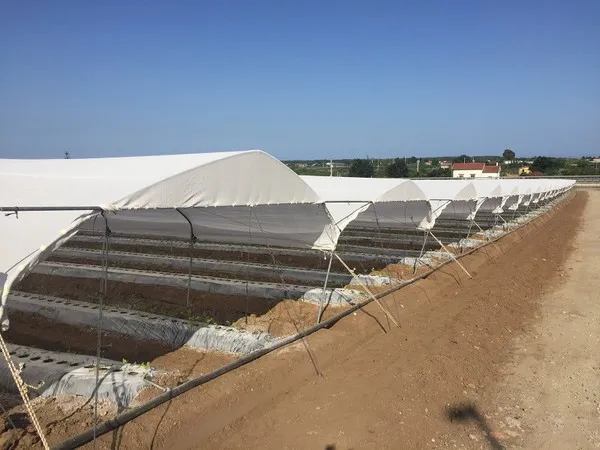Harmful insects and high temperatures are two of the obstacles that berry fruits producers most face in summer, since they risk compromising crop quality, while creating uncomfortable conditions for workers. Arrigoni responds to these problems with two sustainable and high-tech proposals, which protect plants and increase productivity: Robuxta, the range of thermo-reflective screens that lowers temperature even by 5 degrees in the hot months, and Biorete, effective in insect protection, such as Drosophila Suzukii and Tuta Absoluta.
Berries face no crisis; thanks to the growing interest they spark in the consumer searching for 'superfoods' with extraordinary health properties. However, these crops are very sensitive to environmental conditions. Producers around the world are constantly looking for ways to reduce their environmental impact. Furthermore, for these crops, the number of diseases and pests is increasing and the tools to face these challenges are not multiplying at the same rate, especially considering that the world market today requires a reduced use of pesticides.
Arrigoni, international leader in technical textile sector for agriculture, developed several high-tech proposals, to guarantee profitable production, reduce the environmental impact and optimize both sensory and nutritional quality of berry fruits. This has been demonstrated on the field.

In Policoro, in the South of Italy, a test was conducted on raspberry with Robuxta MDF WHITE thermo-reflective screen, compared to two other types of shading solution: 'plastic film + whitewashing + green monofilament net', and 'standard green monofilament net'. Results were surprising: net production with Robuxta increased up to almost 70% more than the standard green monofilament net. At the same time, the percentage of non-marketable fruit decreased by about 20%. In the case of the 'standard green monofilament net', in fact, a net production of 193 grams per plant was recorded. The solution 'plastic film + whitewashing + green monofilament net' reached 259 grams per plant. Robuxta showed 329 grams per plant instead.
At the same time, the percentage of second-choice fruits also fell sharply, which in the first case was 55%, in the second 45.5% and, with the solution proposed by Arrigoni, instead stood at 36.6 %. During the warmer months, moreover, with Robuxta Mdf White the temperature is lower in the greenhouse, up to 5 degrees Celsius compared to the outside, which effectively contributes to better plant development and more comfortable working conditions.
“The important technological innovations we adopted on our protection screens for berry fruits – explains Milena Poledica, agronomist of Arrigoni – needed a rigorous field test, to evaluate real effectiveness of the solutions adopted. Results have been very satisfactory and have in fact produced a new point of reference for protection systems for berries”.
For complete protection and maximum crop safety, Robuxta Mdf White can be integrated with Arrigoni's BIORETE AIR PLUS screens, made of high tenacity polyethylene monofilament, effective in preventing harmful insects from reaching crops and causing damage, while increasing air circulation inside. With holes of 1.02 x 0.88 mm, Biorete consequently reduces the need for pesticides, countering the attacks of Drosophila Suzukii, Tuta Absoluta and other insects.
Berry fruits, in recent years, are experiencing a real commercial explosion. Furthermore, there are several countries in the world where large-scale production is being planned. United States are currently the largest producer of blueberries, with a total quantity of around 700 thousand tons per year. In Italy, however, 6 - 7,000 tons are produced, on 1,200 hectares of surface. Peru is also experiencing a real "boom", with production that has marked a + 796% in the last four years. Moreover, 13.4 million tons of berries (strawberries included) were collected worldwide in 2017, and 15.4 million tons are expected in 2020.
Among the most receptive countries is currently the UK, where berry purchases increased by 50% over the last five years which – within the fruit and vegetable sector – represent the best-selling category at the moment.

